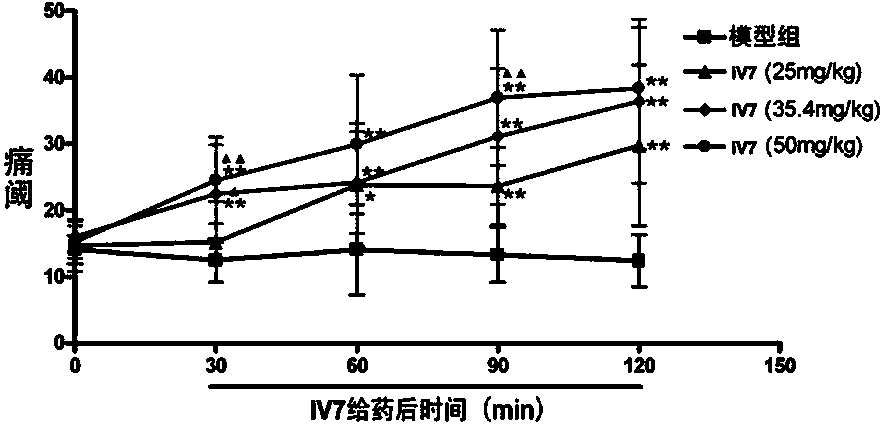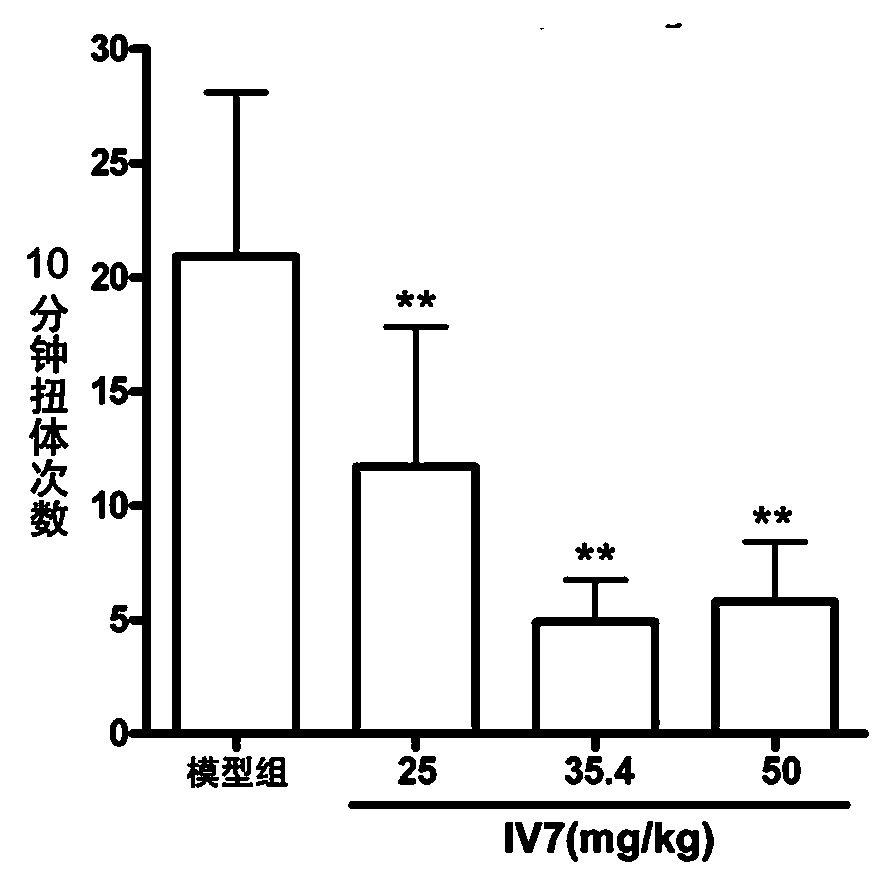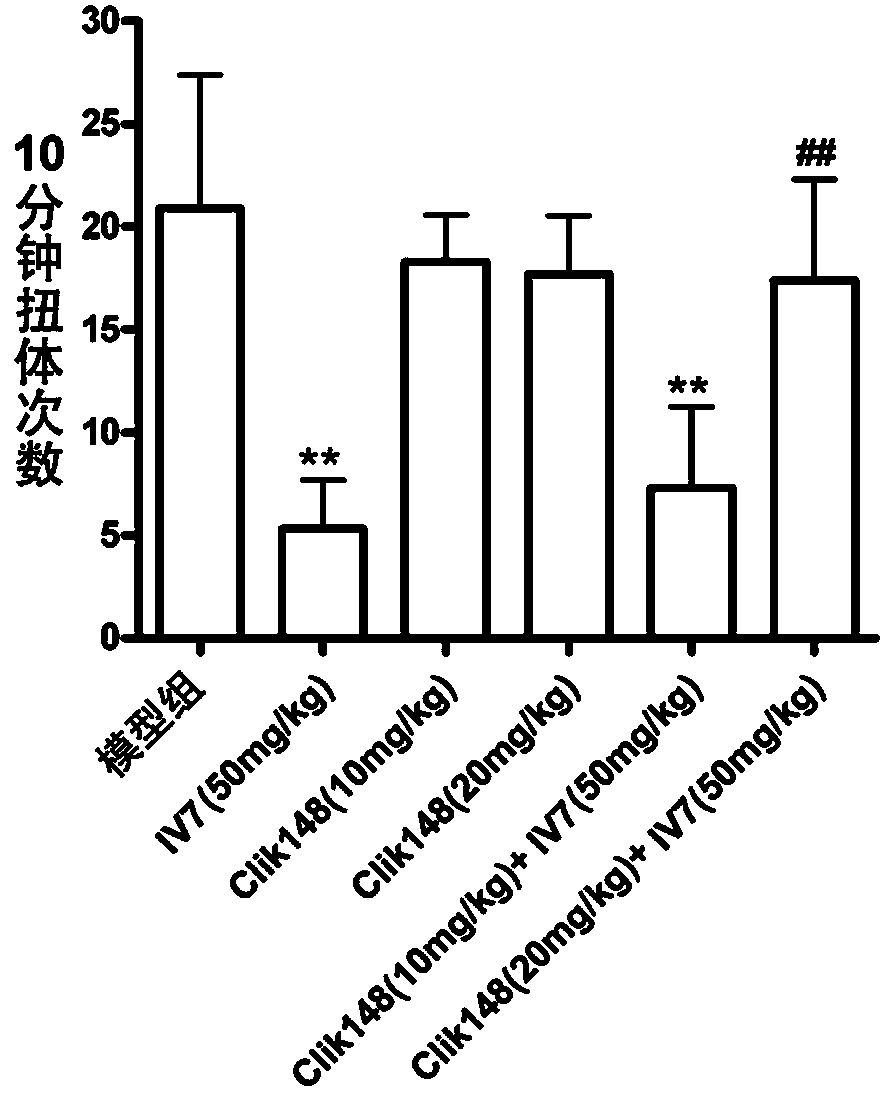Application of (E)-2-(3,5-dimethoxybenzylidene)-cyclopentanone in preparing medicines used for treating pain diseases
A drug and pain relief technology, applied in drug combinations, neurological diseases, antipyretics, etc.
- Summary
- Abstract
- Description
- Claims
- Application Information
AI Technical Summary
Problems solved by technology
Method used
Image
Examples
Embodiment 1
[0023] compound The effect on the hot plate response in mice, the compound is hereafter referred to as IV 7 .
[0024] 40 male mice were randomly divided into vehicle control group (model group, model) and IV 7 High, medium and low dose groups (50mg / kg, 35.4mg / kg and 25mg / kg), 10 rats in each group. Mice in each group were injected intraperitoneally with vehicle or IV 7 After 30, 60, 90 and 120 minutes hot plate reaction. The shorter the hot plate reaction time, the more severe the pain of the mice.
[0025] attached figure 1 for IV 7 Effects on hot plate responses in mice. mean±SD, n=10; compared with model group, **p 7 25mg / kg comparison, ▲ P﹤0.05, ▲▲ P﹤0.01.
[0026] figure 1 The results show that: compared with the model group (vehicle control group), IV 7 50mg / kg, 35.4mg / kg and 25mg / kg significantly prolong the hot plate reaction time of mice, and IV 7 The analgesic effect of 50mg / kg and 35.4mg / kg was significantly stronger than that of IV 7 25mg / kg, ins...
Embodiment 2
[0028] Compound IV 7 Effects on the writhing response in mice
[0029] 40 mice, half male and half male, were randomly divided into vehicle control group (model group, model) and IV 7 High, medium and low dose groups (50mg / kg, 35.4mg / kg and 25mg / kg), 10 rats in each group. Mice in each group were injected intraperitoneally with vehicle or IV 7 After 50 minutes, 1% acetic acid solution was injected intraperitoneally, and the times of writhing of mice in each group were recorded for 10-20 minutes after injection of acetic acid solution. Writhing response inhibition rate=(writhing number of times in the vehicle control group-IV 7 writhing times) / writhing times of vehicle control group×100%. The more times of writhing, the more severe the pain of the mice.
[0030] attached figure 2 for IV 7 Effects on the writhing response in mice. Mean ± SD, n=10; **p <0.01 compared with model group.
[0031] attached figure 2 Show: compare with model group (vehicle control group), I...
Embodiment 3
[0034] Cathepsin L specific inhibitor Clik 148 to compound IV 7 Analgesic effects
[0035] 60 mice, half male and half male, were randomly divided into 6 groups, respectively vehicle control group (model group, model), IV 7 50mg / kg group, Clik 148 10mg / kg group, Clik 148 20mg / kg group, IV 7 50mg / kg + Clik 148 10mg / kg group and IV 7 50mg / kg + Clik 148 20mg / kg group, 10 rats in each group. Mice in each group were injected intraperitoneally with vehicle or Clik 148 and intraperitoneally injected with vehicle or IV 7 After 50 minutes, 1% acetic acid solution was injected intraperitoneally, and the times of writhing of mice in each group were recorded for 10-20 minutes after injection of acetic acid solution. Writhing response inhibition rate=(writhing number of times in the vehicle control group-IV 7 writhing times) / writhing times of vehicle control group×100%. The more times of writhing, the more severe the pain of the mice.
[0036] attached image 3 Compound IV for C...
PUM
 Login to View More
Login to View More Abstract
Description
Claims
Application Information
 Login to View More
Login to View More - R&D
- Intellectual Property
- Life Sciences
- Materials
- Tech Scout
- Unparalleled Data Quality
- Higher Quality Content
- 60% Fewer Hallucinations
Browse by: Latest US Patents, China's latest patents, Technical Efficacy Thesaurus, Application Domain, Technology Topic, Popular Technical Reports.
© 2025 PatSnap. All rights reserved.Legal|Privacy policy|Modern Slavery Act Transparency Statement|Sitemap|About US| Contact US: help@patsnap.com



